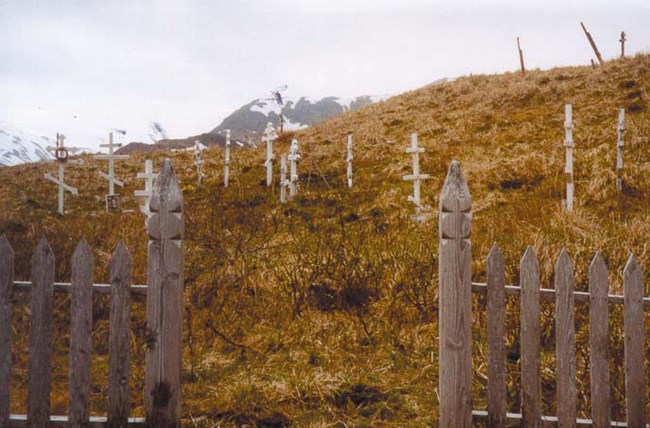Last updated: December 13, 2020
Thing to Do
Unalaska Town Site

Turn right out of the Visitor Center parking lot onto Airport Beach Road; drive south on Airport Beach Road and cross over the bridge to Unalaska Island. Continue downhill past City Hall and cross the Iliuliuk River Bridge. On the north side of the bridge, Airport Beach Road becomes 5th Street. At the first stop sign, turn left onto Broadway Avenue.
Mile 2.8 - Burma Road Chapel (1942)
The former Burma Road Chapel, now the Unalaska Convention and Visitors Bureau, is the only remaining military church on Unalaska Island and Amaknak Island from the World War II era. Despite new doors, windows, and paint, the building is still recognizable as a 1940s-era structure. The Sitka spruce on each side of the chapel were likely planted soon after the chapel was built, as part of the military tree-planting program.
Mile 3.1 - Bomb Site (1942): Bureau of Indian Affairs Hospital
Just past the intersection of Broadway Avenue and Cathedral Way is the site where the Bureau of Indian Affairs Hospital once stood. In early June 1942, hospital personnel received word from base intelligence that an enemy air strike was expected at Dutch Harbor. The hospital staff immediately moved patients to nearby dugout shelters. On June 4, a Japanese bomb hit next to the hospital, severely damaging the building. Only two people were in the hospital at the time, the head nurse and the janitor, but neither was injured. In an interview, ward attendant Martha Tutiakoff recalled that the explosion “tore out the whole end of the building and destroyed the nurses’ quarters and all their belongings. It twisted and shattered the rest of the building...[but] there was no fire” (The Williwaw War). The hospital was rebuilt, but burned in the 1950s.
Mile 2.8 - Burma Road Chapel (1942)
The former Burma Road Chapel, now the Unalaska Convention and Visitors Bureau, is the only remaining military church on Unalaska Island and Amaknak Island from the World War II era. Despite new doors, windows, and paint, the building is still recognizable as a 1940s-era structure. The Sitka spruce on each side of the chapel were likely planted soon after the chapel was built, as part of the military tree-planting program.
Mile 3.1 - Bomb Site (1942): Bureau of Indian Affairs Hospital
Just past the intersection of Broadway Avenue and Cathedral Way is the site where the Bureau of Indian Affairs Hospital once stood. In early June 1942, hospital personnel received word from base intelligence that an enemy air strike was expected at Dutch Harbor. The hospital staff immediately moved patients to nearby dugout shelters. On June 4, a Japanese bomb hit next to the hospital, severely damaging the building. Only two people were in the hospital at the time, the head nurse and the janitor, but neither was injured. In an interview, ward attendant Martha Tutiakoff recalled that the explosion “tore out the whole end of the building and destroyed the nurses’ quarters and all their belongings. It twisted and shattered the rest of the building...[but] there was no fire” (The Williwaw War). The hospital was rebuilt, but burned in the 1950s.
Details
Activity
Scenic Driving
Pets Allowed
Yes
Activity Fee
No
Entrance fees may apply, see Fees & Passes information.
Reservations
No
Time of Day
Day
Accessibility Information
This activity is accessible for all visitors with vehicle access. This is intended as a driving guide. Participants can chose their own level of participation and activity.

UAA Archives & Special Collections, Harris M. Whiting Collection.
The site on which the present Church of the Holy Ascension was constructed in 1898 has been the site of the Russian Orthodox Church in Unalaska for almost 200 years and the spiritual center of the Unalaska community. Parishioners regularly maintain and repair the building. After the Unangax̂ were evacuated from Unalaska in August 1942, the military used the Church primarily as a warehouse until 1945, and the building received no maintenance for three years (A Sure Foundation).
When the Unangax̂ returned home in April 1945, they found their church in severe disrepair. Holes in the roof and broken windows had allowed “wind and rain [to penetrate] behind loose shingles and siding, causing a permanent dampness to the building” (Making It Right, Vol. I). The parishioners repaired their church as best they could, but could not afford the extensive structural restoration required, and the condition of the building continued to deteriorate. The Church of the Holy Ascension was designated a National Historic Landmark in 1970. It was restored in 1996 at a cost of 1.4 million dollars, with funding from the National Trust for Historic Preservation, the Aleutian Pribilof Islands Association, and the Russian Orthodox Church.
Mile 3.2 - Bishop’s House (1883)
The Bishop’s House, with its distinctive Italianate styling and Victorian trim, was designed and constructed in San Francisco, shipped piece by piece to Unalaska, and then reassembled at its present site. The 30-foot-square elementary school that was once attached to this building burned in 1960.

This small memorial park was constructed in 1992 next to the Unalaska Cemetery. The park displays memorial plaques honoring Unalaskans lost at sea, the U.S. Coast Guard, and the Unangax̂ people and military personnel who died during World War II. Benches overlooking Illiuliuk Harbor flank a pill box and the 9-foot-high, solid brass propeller salvaged from the S.S. Northwestern by the City of Unalaska. Most of the grave markers in the cemetery are Russian Orthodox, and some of the gravesites and surrounding fences are more than 100 years old.

